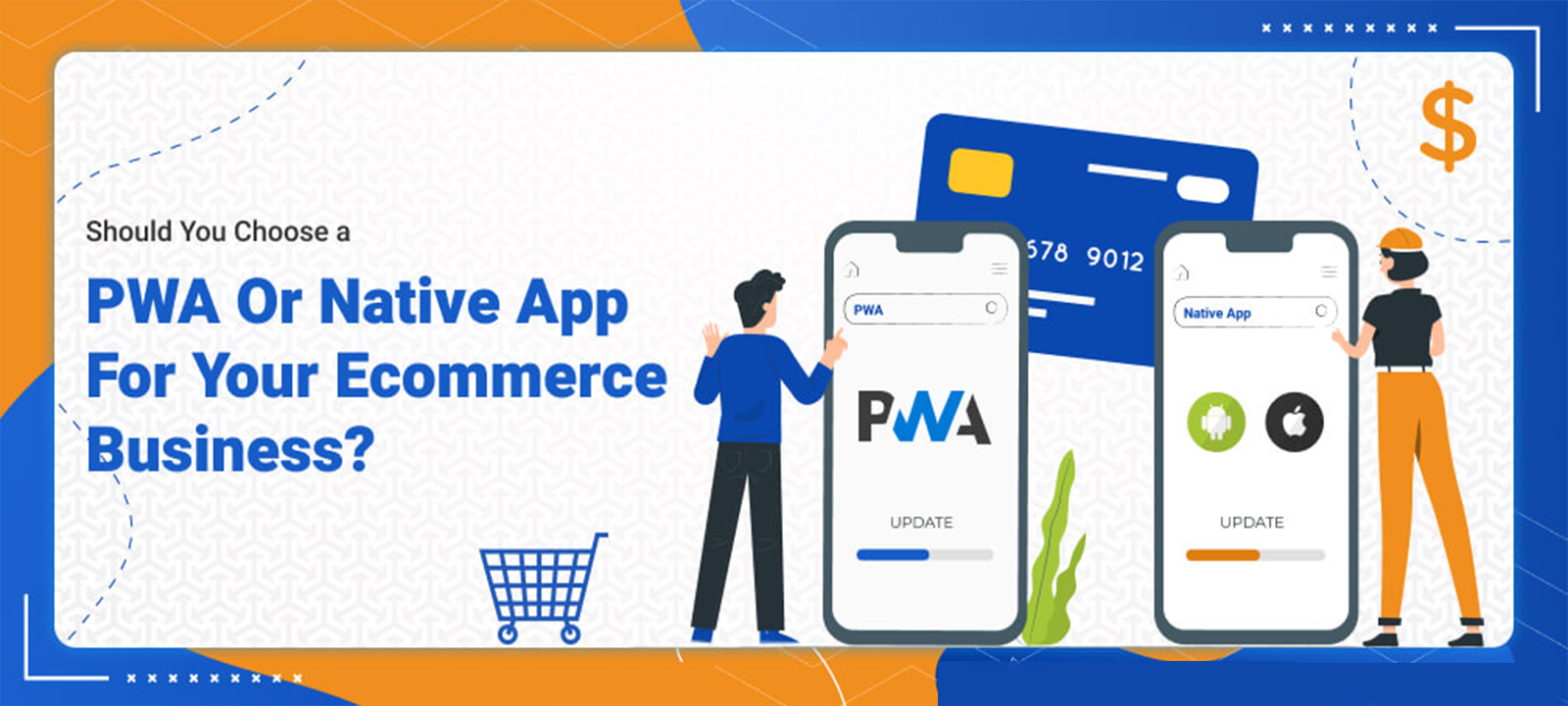The number of mobile consumers has been growing steadily. To meet modern customers’ demands, ecommerce entrepreneurs have to provide a fast, easy, and seamless mobile shopping experience. That’s where mobile apps and progressive web apps (PWAs) come in. Android and iOS native apps are known for their advanced functionality and exceptional performance. Yet more and more companies including reputable ones like Uber and Forbes are turning to progressive web applications (PWA) instead. But which should you choose: a progressive web app or a native app? To make an informed decision, you’ll first need to know the pros and cons of each approach. To simplify things, we’ve written this guide about the differences between PWAs and native apps and how businesses can benefit from each.
Progressive Web App (PWA):-
A progressive web app is a website that acts like a native mobile app. The main difference between a native mobile application and a PWA is that a PWA operates in a browser, so there’s no need to download it from an app store. Developed with the help of HTML, CSS, JavaScript, Angular, React, or other web technologies, PWAs look and perform very similarly to mobile applications, but through a browser. PWAs aim to capitalize on this time by marrying the experience of an app with the immediate accessibility of visiting a website.
pwa-vs-native-app-1
- Offline connectivity:- Progressive Web Apps offer something that both native apps and website cannot. The ability to load the entire page/ application without requiring an internet connection! Nothing is worse than frustratingly watching your 4G trying to load something and giving up after waiting for an eternity. That won't ever happen to a Progressive Web App. Which can be a total lifesaver when you need it most.
- Security:- All Progressive Web Apps are secured via HTTPS coding to ensure your content and your users are safe from virus and online hackers/ spying.
- Compatibility. Since a PWA is accessed via a browser, it runs on any type of OS and mobile device (smartphone or tablet).
- Lower costs. Because a progressive web app is still a website, you don’t need a large budget for its development. Due to its compatibility with any platform, a PWA is developed once, meaning you’ll need only
one development team.
- URL access. You don’t have to download and install a PWA to start using it. You only need to access it via a browser, then pin it on your home screen to have it always on hand. Besides, like any website, a PWA can be shared through a short URL.
- SEO benefits. Technically, a PWA is a website. To this end, instead of launching a marketing campaign, you can rely on SEO benefits for its promotion. Plus, due to Google’s mobile-first indexation policy, your app will be given a higher ranking.
- Memory-friendly. Since a progressive web app is not downloadable, it needs only a small amount of memory.
Cons of PWAs:-
- Limited hardware access. Such apps have limited access to software and hardware features. For instance, they do not support features that are not maintained by HTML5. Additionally, for iOS devices, PWA doesn’t yet work with Face ID and Touch ID, Siri, In-App payments, and Apple’s other primary features.
- Battery consumption. A progressive web application needs Internet access; that’s why it drains the battery pretty fast. Another reason for excess battery consumption is that PWAs run on technologies that aren’t intended for the mobile environment. As a result, devices need to work harder to interpret the code.
- PWAs can’t do everything:- As capable as PWAs are compared to traditional web apps, they can’t do everything mobile apps can do. Because they are written in JavaScript, they are not as battery efficient as apps written in native languages. Their performance is also not as good as the performance of native apps.
- No download store:- Despite PWA’s main advantage (short app downloading process), these apps are missing out on a considerable number of users who mainly use the app store to find and download apps.
Native Apps:-
Unlike PWAs, native or mobile apps are developed for a specific OS and offer a broader scope of features. Using the hardware and software capabilities of a device, native apps provide stellar performance and smooth customer experience. To start using a native mobile app, users have to download it from an app store. Native mobile apps are developed to operate optimally on either iOS or Android. It has the ability to use device-specific hardware and software. They are developed specifically for one platform, and can take full advantage of the device features. they can work much faster by harnessing the power of the processor and can access specific hardware like GPS. Native apps can use the device’s notification system.
Pros of Native apps:-
- Speed and performance:- It is faster and keeps an eye on memory. It has better battery backup and thus it improve the overall speed and performance.
- Flexibility:- The app gets full access to camera, databases and various other functions of the smartphones.
- Support from app store:- Google Play and app store provide complete support to the users and they can download anything online easily. • Data protection:- Hardware resources are efficient and everything is connected to mathematics in Native, thus it ensures full protection of data. • High performance and great UX:- The direct interaction between the code and the underlying resources results in high performances. Also, native apps generally have a better UX that is synonymous with the platform. • Customizability:- Native mobile applications provide great opportunities in terms of the interface and user experience. Online store owners can customize their stores as they desire and stand out from the crowd by adding unique features.
Cons of Native apps:-
- High cost:- Native mobile apps are complex to develop and costly to maintain, unlike PWAs. Ecommerce store owners have to develop a mobile app for each platform and then maintain them.
- Memory consumption:- One of the key disadvantages of mobile apps is they take up too much RAM.
- Promotion costs:- Since you can’t use the power of SEO with mobile apps, they require additional promotion in the app stores.
- Long development process:- In the native app development, developers are required to deploy unique features at each stage of the development. It ultimately needs more time and technical work, and hence, the development process becomes longer with particular workings at each phase. Native app development requires a technical process for each platform that increases the hours spent and cost over development. Therefore, native app development is not a good option for businesses with a limited budget.
Conclusion:-
Overall, we can see that there are both positive and negative aspects to both native apps and web apps. One thing to always remember is that they world is becoming more mobile each and every day and having a mobile app will allow you to engage more with your audiences. There are many things to consider, like cost, available platforms, development time, etc., the high performance of native apps versus the more natural user acquisition of PWAs is what sets these two apart. Although native mobile apps offer a wider spectrum of functionalities for the user, Progressive Web Apps present themselves as the new standard for mobile-first solutions. PWAs are a rapidly developing technology and each day we see new engaging features within. There are many reasons to choose native app development over PWAs like great user experience, better security, less maintenance, best performance, scalability and so on. In spite of the higher development cost, native apps offer more benefits in the long run.
As time goes on, it will be interesting to see how these two offerings are going to shape the app development world.


